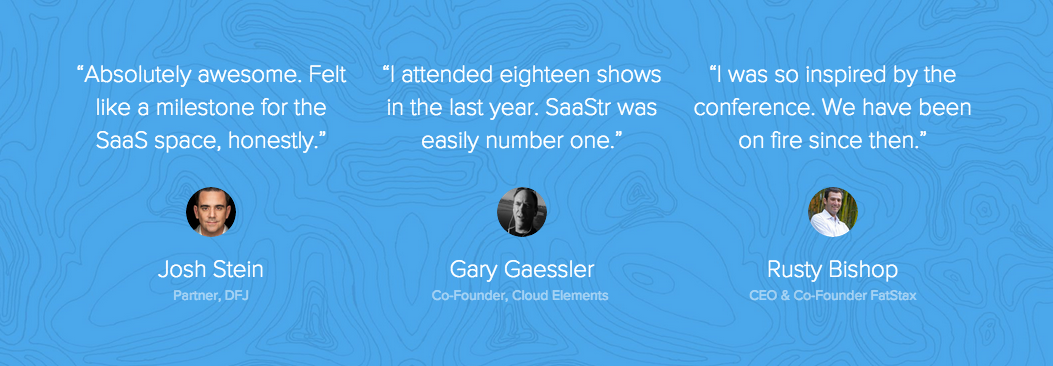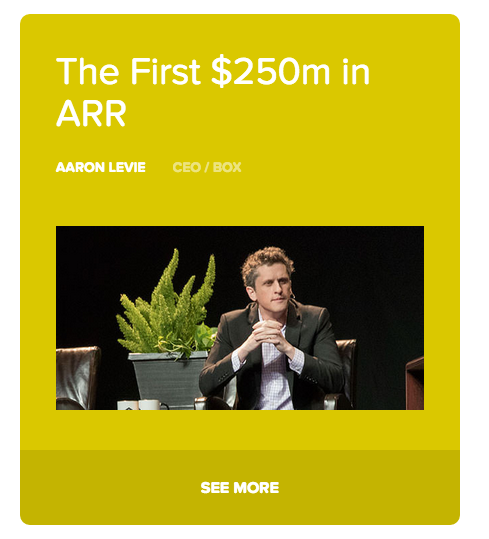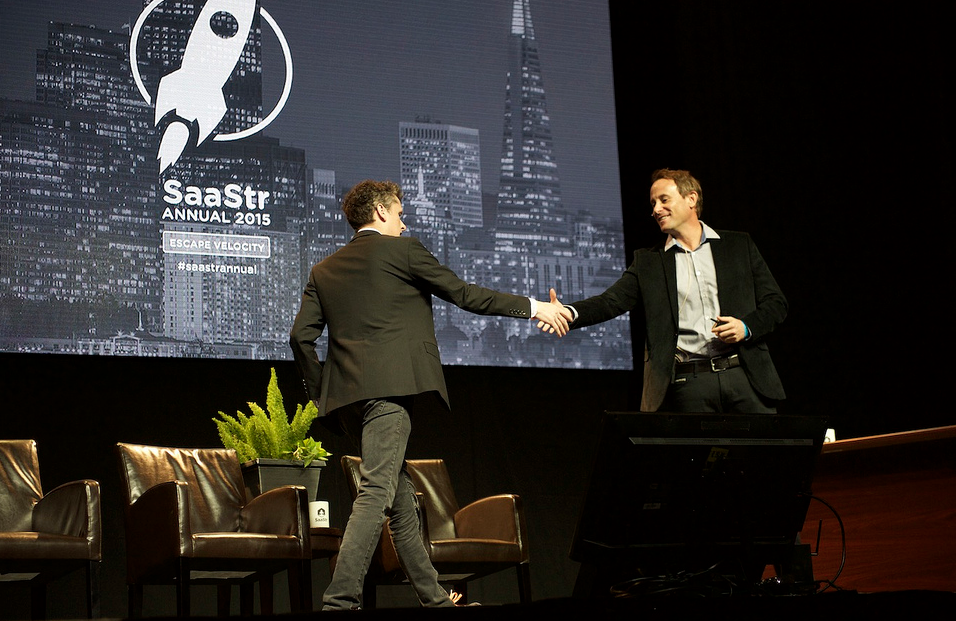Missed the 2015 SaaStr Annual? We’ve got your back. We’ll do a series where we publish both the videos and full transcripts of all the sessions. First up is Aaron Levie of Box, where we had a wide-ranging, 45 minute deep dive on how Box scaled from $0 to $250m in ARR.
As you’re reading … sign up for the 2016 Annual super early and get 50% off and 20% off again (however that math works) if you use the code ALLSTAR here: www.saastrannual.com. It will be a full week (or at least, 3 full days) with 5,000+ of your SaaS co-founders and even more amazing speakers and content than 2015. And we’ll sell out — so if you don’t buy early, don’t complain later. 🙂
To me some the most interesting things in the interview were digging in on what it’s really like going upmarket and selling to the enterprise. Of spending 50% of your time on the road. Of selling solutions, not tools anymore. Nino Marakovic of Sapphire Ventures picked up on similar themes the other day on TechCrunch here.
Check it all out below.
——-
Jason: Hey, thanks for coming.
Aaron Levie: How are you doing?
Jason: Good. It’s good to see you.
Aaron: Good to see you.
Jason: Sorry, we kept you backstage for an hour or something like that.
Aaron: No, it was nothing like that. How’s the sound doing?
Aaron: So you’re like the Jimmy Fallon of SaaS now. Is that the…
Jason: [laughs]
Jason: You guide me.
Aaron: At first, because on the Internet, it was looking more like you were heading the Tony Robbins’ direction, but…
Jason: Tony Robbins’ direction.
Aaron: Because I didn’t know about this setup.
Jason: Well, thanks for coming.
Aaron: Thanks for having me.
Jason: It’s been busy the last few weeks?
Aaron: We wanted to make sure we went public before this event. If you’d only done it a year ago, it would have been more convenient actually.
Jason: [laughs] Good. Was it tiring?
Aaron: Which part?
Jason: The whole Roadshow IPO, or is it just another piece of a pie eating contest? how are you feeling today?
Aaron: Well, you made me wake up at 8 AM, This morning, I’m a little bit more tired.
Jason: Apologies.
Aaron: It’s interesting. I think the most interesting dynamic of the Roadshow is the way I thought about it is it’s like doing a growth stage party round. You go pitch 400…
Jason: There is no lead investor [in an IPO], right?
Aaron: Yeah.
Jason: No one’s taking the whole chunk.
Aaron: You go out, you pitch 400 investors, and you see who wants to get involved.
Jason: Well, good. There are a million things that…
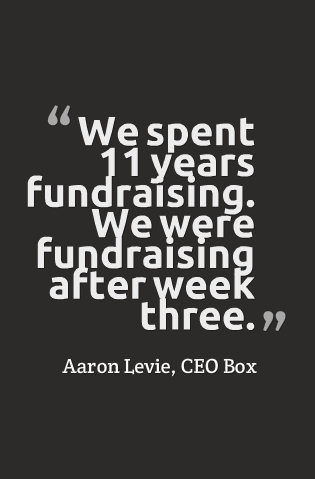 Aaron: I’m sure it’s harder than that for other people, like bankers and everything. It was meeting after meeting after meeting explaining how SaaS works.
Aaron: I’m sure it’s harder than that for other people, like bankers and everything. It was meeting after meeting after meeting explaining how SaaS works.
Jason: You’ve spent 11 years fundraising.
Aaron: Yes. We were…
Jason: It’s not a new thing.
Aaron: We were fundraising after week three. This is a pretty common occurrence for us.
Jason: One question, and then I want to go back. You spoke with 400 institutional investors. They understand SaaS, right?
Aaron: They’re working on it.
Jason: [laughs]
Aaron: What we do is we do extreme SaaS. What I think we figured out earlier on in our business model and our market was once you understand the dynamic of SaaS, and I appreciate some of the clarification you’ve been able to put out on the Internet.
Once you understand that dynamic, then actually your growth and your skill, your business is actually most functional to how much you invest in scaling it up. Once we figure that part out, and once capital is relatively cheap, we just decided, “Well why don’t we just go and scale as fast as possible, as big as possible,” because the market for the next many years we are not going to bump up against our total adjustable market.
Our growth is essentially dependent on what level of investment we put in to growing the business, and once we determine that we just decided to push on the gas pedal.
Jason: Just one question just on Roadshow, just curious. At this point, it’s early 2015, what percentage of the institutional investors you talk to do understand customer lifetime value, investment and sales and marketing magic number. Have most of them done their homework by time they got to you?
Aaron: Yes, as with anything in these situations there’s a spectrum of level of education. It’s funny, because actually so you have on one end of the spectrum you had these meetings where literally the person that we are pitching was an investor in IBM and EMC. They are like, “Well where is the cash flow?” That was one end of the spectrum.
Jason: You still get those? Yes?
Aaron: You still get those. On the other end of the spectrum you would have people that would say, “Why aren’t you spending more,” and if you have this annuity essentially that continues to grow and you have this recurring revenue stream.
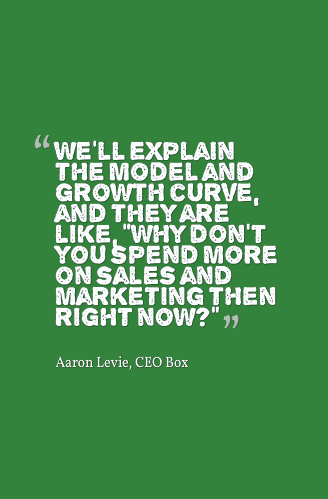 Why would you even decide not spend 500 million on sales and marketing, just keep scaling it up. Then you have somewhere in between which is actually the funniest, because they’ll go into the meeting. They’ll start the meeting and they’ll say, “The economics of your business are confusing. We don’t know why you are not profitable yet. What’s going on here? Why aren’t you figuring out the near term profitability?”
Why would you even decide not spend 500 million on sales and marketing, just keep scaling it up. Then you have somewhere in between which is actually the funniest, because they’ll go into the meeting. They’ll start the meeting and they’ll say, “The economics of your business are confusing. We don’t know why you are not profitable yet. What’s going on here? Why aren’t you figuring out the near term profitability?”
We’ll explain the model and growth curve, and they are like, “Why don’t you spend more on sales and marketing then right now?”
Jason: [laughs]
Aaron: Literally within a 30 minute meeting they’ve gone from IBM cash flow investor to…
Jason: You are learning that on the Roadshow, so we are in the fourth inning of the evolution of thinking here.
Aaron: Sadly not everyone is reading Quora yet…
Jason: [laughs]
Aaron: …in the East coast public market scene. We think the model is catching up.
Jason: Got it. Just one question, I’m curious about that, so you’ve talked to all these institutional investors, is there room for another 10 Box like IPOs? Is there enough appetite out there to do another, is there another check… they can write? there’s huge amount of institutional capital. But for SaaS is there enough appetite for 10 more IPOs like Box this year you think?
Aaron: That would be probably dangerous for me to answer.
Jason: [laughs]
Aaron: What I would say is that there is plenty of room for companies that are benefiting from this very clearly circular change toward cloud and mobile. If you’ve built a significant business on the back or benefiting from that, then there’s room for 100.
I don’t think there’s any particular limit to the appetite. The investors that are betting on this thesis are realizing that, so in our space what we do is, and this is singular most misunderstood part about our business is that people think we are in the storage business.
We buy storage, we buy hard drives or else we can’t store your data, but what we sell you is an application, and service and a platform. The significant difference there is actually when you look at our architecture, storage is one layer, but there is also a security layer, there is a content management layer, there is a search layer, there is a data loss prevention layer.
The big disruption in our particular space is that maybe as an end user you use Box as easy way to share and collaborate our own files. Actually as an enterprise you are saving on your storage infrastructure, your data loss prevention infrastructure, your search appliance, because all that gets compressed in our data center.
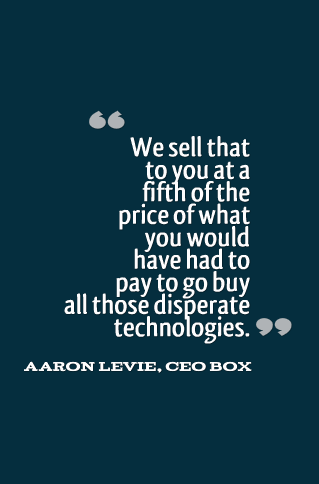 Then we sell that to you at a fifth of the price of what you would have had to go by from all those disparate technologies. From that stand point, it’s very disruptive in terms of legacy, traditional enterprise software and infrastructure businesses.
Then we sell that to you at a fifth of the price of what you would have had to go by from all those disparate technologies. From that stand point, it’s very disruptive in terms of legacy, traditional enterprise software and infrastructure businesses.
For companies that can either drive those disruptive economics in enterprise, or create and go after a new market, there’s going to be essentially unlimited appetite for interesting businesses.
Jason: No, clearly like with Alibaba we see there’s lots of institutional appetite, right. I hope it’s unlimited for SaaS, so it’s good to hear that you’ve at least filled that a little bit from the Roadshow, so it’s a good learning for all of us, right.
Aaron: Yeah. No promises.
Jason: The party isn’t going to end at least in the next 30 to 60 days.
Aaron: Was this a party that…
Jason: [laughs]
Aaron: …I was a part of?
Jason: It didn’t feel like a party ?[laughs] .
Aaron: I don’t know, maybe somebody should have invited me.
Jason: One thing I want to touch on from a founder’s perspective, and I know you’ve probably explained it about 1,000 times on the Roadshow and otherwise. I do want to dig a little bit in the parts of the business model that are not obvious just while I have you. I think of Box…
Aaron: We did this really awkward Roadshow video. You could just play it for 20 minutes if you like.
Jason: Dan had a nice suit. I saw that. He did…
Aaron: We kept being advised, “Do not move your arms.” We are just like, “OK…”
Jason: [laughs]
Aaron: “We’ll just explain SaaS like this then,” and they are like, “Yeah. That’s good.”
Jason: Yes [laughs] .
Aaron: Gives a sense of who the audience is.
[laughter]
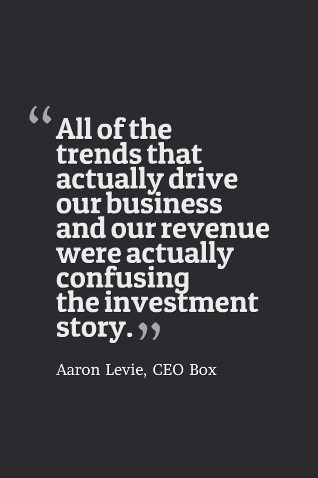 Jason: Obviously we’ve got SaaS business models, but Box also is what I call SML app, because you’ve got small, medium and large. It’s not like Veeva where you’ve got to be pretty big. It’s not just like just small, and so it’s confusing to a lot of folks who touch Box.
Jason: Obviously we’ve got SaaS business models, but Box also is what I call SML app, because you’ve got small, medium and large. It’s not like Veeva where you’ve got to be pretty big. It’s not just like just small, and so it’s confusing to a lot of folks who touch Box.
I’ve got my Box node app right now, which has nothing to do with how your average seven figure customer uses Box?
Aaron: Right.
Jason: A couple of things, let’s start at the high end. Tell me how in a seven figure deal how the CIO thinks about Box, and what they are looking for from it?
Aaron: I think we also didn’t benefit from that part of our business model, which was really interesting.
Jason: Probably not.
Aaron: In the all of the growth years, we actually benefited tremendously from consumerization. It’s fascinating. All of the trends that actually drive our business and our revenue were actually confusing the investment story.
What happens is we build and we try and build software that is going to be incredibly easy to use, incredibly elegant. It should feel like the best thing class consumer technologies, and sometimes it doesn’t and we screw it up.
We are at least as a mission like that is our job. It’s interesting, because by virtue of doing that it ends up confusing a lot of the investor community, because they like, “Well this is like iCloud or something like that.” We are like, “Maybe for just the end user knowledge worker when they load it on their iPad.”
You have to remember that what the enterprises had to deal with is all of this infrastructure and software and security. It was really interesting because I think we were one of the first companies…Many companies with SaaS have gone public.
That model is largely understood. We have an extra derivative of consumerization in SaaS, which made it a little bit more complicated, because you had to be able to separate. There’s something of the IT organizations buys, which is different than what the user has.
Maybe what the user has looks like it’s somehow like a consumer technology, but actually what they are selling is this enterprise thing, and that’s where all the revenue comes from. That’s actually allowed us to be successful with the GEs and Eli Lillys and Toyotas of the world, but to investors, it’s not as simple as just saying, “Hey, it’s an HR system. It’s boring. You won’t understand it, but we make lots of money.” You have to be able to actually wrap your head around two principals at once. What was your question?
Jason: We’ve got GE or Eli Lilly or…
[laughter]
Jason: …Pick your favorite.
Aaron: SML.
Jason: When you go into one of those big deals, who’s buying, and really, why are they buying? What are they looking to do? Is it to control content? Box, we can talk about work flow and all this, but what’s driving that check?
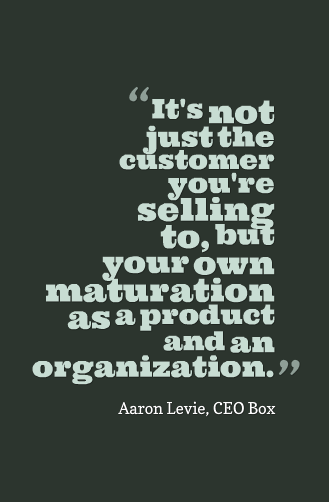 Aaron: This is actually probably the most interesting thing for any start up is that tends to change at each phase that you’re in, and not just the customer you’re selling to, but your own maturation as a product and an organization.
Aaron: This is actually probably the most interesting thing for any start up is that tends to change at each phase that you’re in, and not just the customer you’re selling to, but your own maturation as a product and an organization.
You go back eight years ago, when we decided to focus on the enterprise, and the sale was really to, at best, a departmental level business person, as opposed to even departmental IT.
Jason: Someone who wanted to manage their team, right?
Aaron: Yeah,
Jason: Just make sure we’re on the same page with content in my team, my guy, my sales team, whatever it is.
Aaron: It was the sales manager, it was the marketing manager, it was the product manager of a hundred person unit, right?
Jason: If that’s all you did, how big would Box be today, do you think, if that was all you sold?
Aaron: Probably a billion dollars or something…
[laughter]
Aaron: …Because we would have spent less on sales and marketing. That was a joke.
[laughter]
Aaron: We would be a $25 million business. It would be a productivity app, which is completely nothing wrong with a productivity app, believe me, but it would not have been able to be in a strategic conversation with the CIO.
You start at the productivity conversation, and that is generally a sale to a department or a team, and then what started to happen was, it was interesting. If you really go back, how long do you want to make this? When am I off?
Jason: We’ve got time.
Aaron: When’s Bob on?
Jason: We gained a few extra minutes. We’ve got 33 minutes…
Jason: …So take your time.
Aaron: That 33 is just me?
Jason: I gave you a few of my minutes. You don’t have to use all of them. [laughs]
Aaron: OK.
Jason: But we don’t have to go back to ’04, ’08’s far enough back in time. [laughs]
Aaron: OK, got it.
Basically, when we started the company, the idea was just really simple and secure file sharing and collaboration. It got brought into businesses at the team and individual level, and what we got really lucky on was, all of a sudden, iPads, Androids, Android phones, iPhones, Amazon Web Services, salesforce.com, getting to real scale.
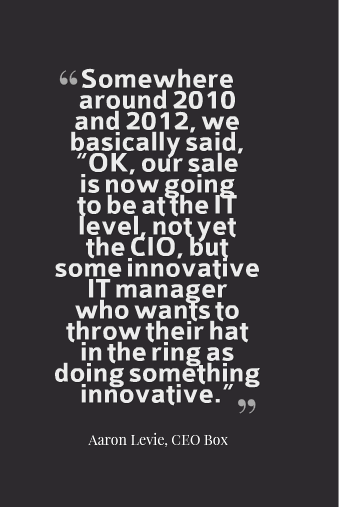 And out of nowhere in a three year period, while between ’06 and ’07, and maybe ’10, we were a “nice to have,” a sort of, “Yeah, that’s kind of OK to have in the corner of the enterprise,” just the definition of shadow IT with maybe a little bit more, broader implications, to all the sudden, you had this redefined IT landscape where all the new devices, all of the new ways of working, didn’t work with the legacy content management and collaboration software.
And out of nowhere in a three year period, while between ’06 and ’07, and maybe ’10, we were a “nice to have,” a sort of, “Yeah, that’s kind of OK to have in the corner of the enterprise,” just the definition of shadow IT with maybe a little bit more, broader implications, to all the sudden, you had this redefined IT landscape where all the new devices, all of the new ways of working, didn’t work with the legacy content management and collaboration software.
Somewhere around 2010 and 2012, we basically said, “OK, our sale is now going to be at the IT level, not yet the CIO, but some innovative IT manager who wants to throw their hat in the ring as doing something innovative.”
That was really where we were being able to start to have more strategic conversations, and so we went from purely departmental to actually being able to be implemented in the enterprise, and that was still only at a thousand employees or 5,000 employees.
Only in the past year and a half, has that then gone to CIO level, which is, “How do we become a strategic part of the IT architecture? How do we actually build one of the key pillars of their enterprise?”
Jason: Now it’s 2015, right? Is Box a part of the CIO’s stack today, a checklist, something they’re looking to bring into the enterprise? Where is it on that evolution?
Aaron: We certainly would like it to be, right?
Jason: Yes, or let’s call it cloud content matter. Sorry, what’s the right acronym I should be saying? [laughs]
Aaron: We call it Enterprise Content Collaboration.
Jason: Enterprise? Let me just get that right.
Aaron: Yeah.
Jason: Enterprise.
Aaron: Content.
Jason: Content Collaboration. Got it, makes sense.
Aaron: The reason for that is, is that it’s sort of ECM, which is Enterprise Content Management, but it’s not just about the management. It’s actually, “How do you use and collaborate on your content?”, but…
Jason: For sure, but ECM is a traditional part of the stack, there’s no question, right?
Aaron: Yep, and actually what’s funny is ECM was never a strategic buy for the CIO. That was actually still one level below the CIO. The CIO was ERP, CRM, Core Infrastructure, those kinds of major applications.
What’s changed is you have the CIO of GE, Jamie Miller, she’s responsible for 350,000 people’s technology, and if she spends her time in meetings about their accounting system and about their 10 data centers, and what’s going on with that, and what is their capital outlay, she is going to miss the boat on, “What does Jeff Immelt need in his hand to access his email? What does the person who’s going to be a field service agent repairing a jet engine, what apps are they going to need?”
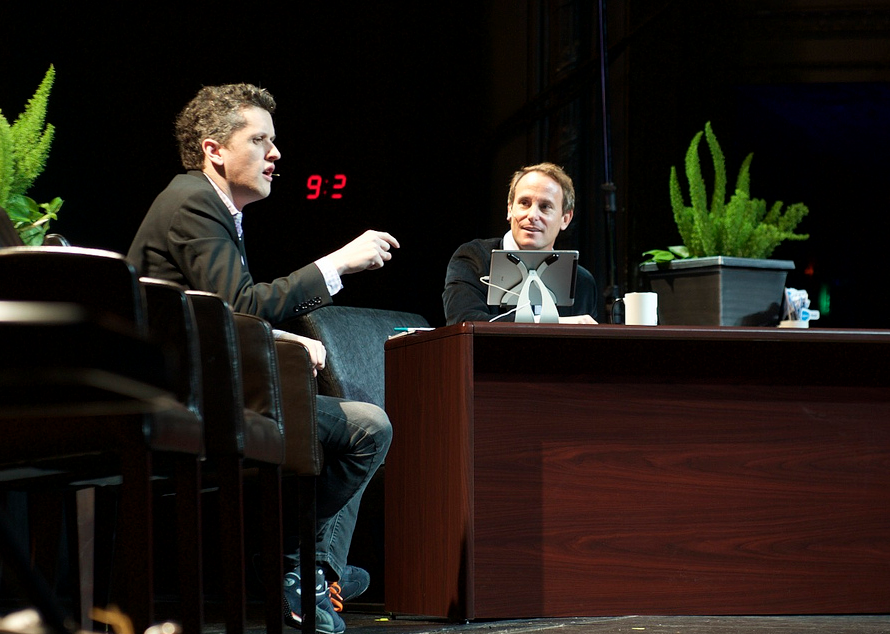 So her purview is the same, but the things that are within that are completely different, and so you now have innovative CIOs like Jamie Miller, who then say, “I actually am not going to differentiate how I deliver IT if I do the world’s best Oracle implementation. IBM’s got that for us. We’re just not going to worry about it. It is what it is. It’s not going to be totally transformational.”
So her purview is the same, but the things that are within that are completely different, and so you now have innovative CIOs like Jamie Miller, who then say, “I actually am not going to differentiate how I deliver IT if I do the world’s best Oracle implementation. IBM’s got that for us. We’re just not going to worry about it. It is what it is. It’s not going to be totally transformational.”
I’m sure Oracle and IBM would say otherwise, but generally, it’s not going to completely change their business. What might change their business is, “Can they enable their employees to be more productive? Can they actually get more performance out of the business with new applications?”
She’s actually having a very start up oriented mindset, like, “Who in the ecosystem should I be working with that’s going to give me that next generation set of technologies?” Largely it’s going to be companies in this room. It’s going to be companies like Salesforce and Workday, and that means that we’re becoming now a strategic layer in the enterprise, because we can represent really driving that mix between end user productivity, but also saving you tens of millions of dollars on your infrastructure that now you just don’t have to go manage.
Jason: It’s interesting, with the case of her, that’s still a hero story, right?
Aaron: Yep.
Jason: What I mean is, we all lived through this. We have a champion, and it’s like the one innovative thing that they deployed this year in the enterprise, right?
Aaron: Yes.
Jason: At some point, Box will be big enough, that won’t be true any more, right? Because, “I’ve got to deploy, I’ve got to manage cloud content, cloud, cloud…”
Aaron: Yes.
Jason: …It’s not an option anymore. It’s not innovative. Innovation, it’s requisite. My thesis would be, it’s a learning for me today, I thought you would be about to cross that chasm where some of your customers, it’s less about innovation, and it’s more about, “OK, control. Look, there’s all this content flying around. It’s scary, and Box is the coolest thing I can bring in, but yet control what’s happening in the enterprise,” right?
Aaron: Right, so…
Jason: And that’s what’s about innovation, right? Then control.
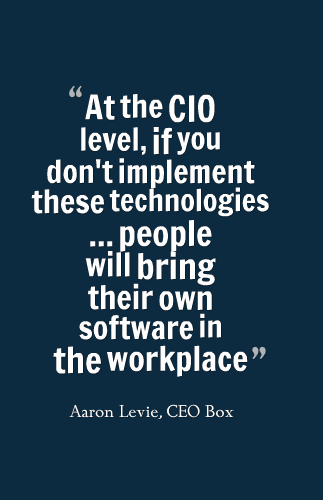 Aaron: Correct. That was the champion. Now let’s get to the end practice. The champion is the CIO, Jamie Miller. She has a person under her named Larry Biagini. He’s the CTO, and he was the former chief risk officer of GE. His job is to only implement technology that’s going to make GE safer and more secure, and not actually introduce new risk.
Aaron: Correct. That was the champion. Now let’s get to the end practice. The champion is the CIO, Jamie Miller. She has a person under her named Larry Biagini. He’s the CTO, and he was the former chief risk officer of GE. His job is to only implement technology that’s going to make GE safer and more secure, and not actually introduce new risk.
The conversation with Larry Biagini, and every SESO in the world right now, every head of compliance in the world, every head of risk, is if you don’t implement these technologies, largely these new end user, more user friendly, mobile, consumerized technologies, that also give you control at the enterprise level, what’s going to happen is two things.
One is, the people will bring their own software in the workplace, which is a trend that we benefited from for many years, but at the scale of GE is a very dangerous proposition when it comes to managing data.
On the other end, and what we’ve seen with Sony, what we’re seeing, essentially every day is the legacy infrastructure is actually worse off and actually introducing vulnerabilities into the enterprise environment.
You’ve had a whole cycle now of enterprises starting to grapple with this reality, which was the legacy IT model assumed that you built out lots of infrastructure, you built out lots of software, you put a perimeter security model around that, and assuming everything was within that perimeter, then you’re totally secure.
What we’ve found is that all you have to do is poke one hole in that perimeter, and then boom, you have everything. That was because the security stack was separate from the storage stack, which was separate from the content management stack. All of these things were disparate components that never were integrated, because they came from different vendors, and they all sort of assumed it was somebody else’s responsibility, from a software standpoint, to solve that problem.
Now you have organizations that are recognizing that actually it’s my legacy architecture that is keeping me unsafe or preventing me from becoming safe, and I’m going to have to have a modern architecture. Modern architecture doesn’t always mean cloud, but at least in our space, if you’re talking about sharing and collaborating, if you’re talking about accessing data remotely, then cloud is largely the right delivery mechanism for that set of capabilities.
Our customer conversations today is not pitching cloud. It’s actually pitching a modern architecture, and in that modern architecture, you get visibility, control, granularity, you get all of the things that you would have wanted to design in a content management and collaboration system, if it came with security, and if it came with all those components.
Jason: Going to that, at the scale Box is at today, when you go and talk with the CIOs and the folks, how important is product? What I mean by that is, you go and pitch Salesforce today, don’t get me wrong, the product’s important, but it’s not really about whether it has the best leads, contacts, and opportunities, right?
You have to have the best demo, the best configuration, but if you’re talking about security and compliance, on the product side, is it pretty mature? Is it pretty figured out now? Is that a big part of the discussion?
Aaron: When you say “product,” do you mean on the user side or just the backend technology?
Jason: I think for the audience here, I’m guessing when you go in to pitch a seven or eight figure deal, it’s not like you’re talking about features. [laughs]
Aaron: Actually, some of our best…
Jason: Or perhaps you are.
Aaron: I think you’re calling it the hero sale, right? In that situation, it’s actually still our demo, which is hands down the best way to get somebody excited, because they’ve never seen that demo before, with security, with compliance, with the control.
You’ve never been in a hospital and seen beautiful software that’s also HIPPA compliant. You haven’t been in a financial services institution where you can share and collaborate in a consumer like way, but also have FINRA compliance, so it ends up being that connection between these two disparate and two traditionally paradoxical combination of, “How do you have simplicity with security and with these controls?”
Again, the reason for that was, traditionally, a whole bunch of reasons. People just sucked at building enterprise software before, but then also, the SharePoint product manager assumed that somebody else was going to solve the security, and so by the time you actually got implemented in the enterprise, the SharePoint product managers can do anything they want all day long to be innovative, but when it actually gets implemented in an enterprise, all bets are off on how your product is actually going to work and perform.
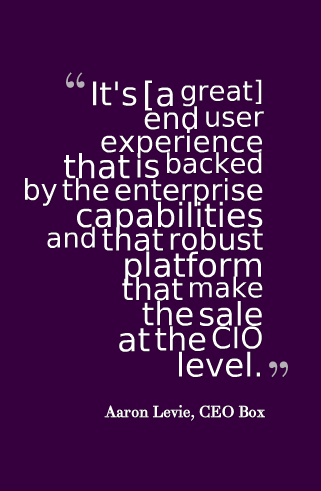 It is actually still that end user experience that is backed by the enterprise capabilities and that robust platform that make it a sale that works at the CIO level.
It is actually still that end user experience that is backed by the enterprise capabilities and that robust platform that make it a sale that works at the CIO level.
Jason: I’ll tell you a quick anecdote to that. You had me on a panel at BoxWorks a couple of years ago, when it was smaller, and I don’t know what I said, but one of your customers came up to me afterwards, and she said, “That’s not what Aaron told me.” “Oh, God.”
Aaron: [laughs] So what did I tell her?
Jason: I remembered it…
Aaron: Or what did you say?
Jason: I don’t even, it doesn’t matter. What was interesting was the personal connection, and it was a pretty good brand name customer. So especially now, with CIOs and others, how do you spend your time with customers, like prospects, existing customers? What’s your job? How’s that changed, if at all, at some level, over the last couple of years? What your advice to the folks here?
Aaron: This is tough because my evolution was different than probably how I would recommend other people to do it.
Jason: That’s why we’re here, because of learnings.
Aaron: Learnings.
Jason: Learnings.
Aaron: I saw the point of this thing. Got it.
Jason: We’ll make sure we pitch whatever we want to pitch in our remaining time, but learnings are the goal.
Aaron: I thought I was trying to get sign ups.
[laughter]
Aaron: When we started out, literally for the first six or seven years, I was very product focused, very internally focused.
Jason: You sat in the middle of the team, as I remember.
Aaron: Yes.
Jason: In the pit with all the developers wherever you are. You come out, you pop out.
Aaron: I still do.
Jason: You still do.
Aaron: I still do, but I’m in the office virtually less frequently. Part of this was consistent with our sales model. It was an inside sales model and the people we were talking with didn’t demand an in person meeting, so we could accomplish that. Actually, I was rarely even on the phone with customers.
Our real customer interaction was driven by our first head of sales, our first sales individuals and sales team. I was super product focused and then we had sales operations. We would meet almost daily, like, “Hey, what are you hearing? What’s going on in the field? What are customers asking for?”
Then we would, through any means necessary, try and build the things that we thought were going to be important for these customers. That worked up to a certain stage of customer credibility and…
Jason: Yeah, small silo deals into departments. Got it.
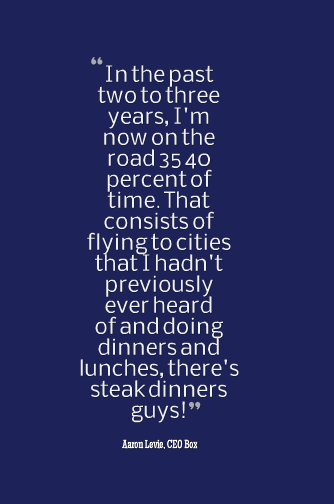 Aaron: Exactly. Finally, we got to a stage where the decision maker was going to be the CIO. That required a level of commitment on our end and then to see that this was something that I personally and the company was signing up to support them and work with them.
Aaron: Exactly. Finally, we got to a stage where the decision maker was going to be the CIO. That required a level of commitment on our end and then to see that this was something that I personally and the company was signing up to support them and work with them.
In the past two to three years, I’m now on the road 35 40 percent of time. That consists of flying to cities that I hadn’t previously ever heard of and doing dinners and lunches, there’s steak dinners guys!
Jason: We talked about steak dinners more today. You didn’t know those worked, back in ’04 and ’05, right?
Aaron: I didn’t think we would ever have to do them.
Jason: But they work, don’t they?
Aaron: To me it’s more a practicality. You have so many hours in a day. Some of those hours, people eat food. If you can combine food and meeting a customer, it’s really convenient. Maybe it would sound better if we called them “sandwich dinners” or “sushi dinners.” I rarely eat steak specifically. It’s less mysterious when you’re actually there because you’re eating and talking about IT.
Jason: You got pretty far spending zero percent of your time directly interacting. Is the learning that you would have done more?
Aaron: I would have done a lot more. I think we got away with it because we could be our best customer. Our own company was scaling at the rate that our customers’ environment adopted. When we were 200 employees, our biggest customers were maybe 500 user deployments. We knew like, “OK, what is the security you need? What is the content management capability need?”
Then, the size of our customers started to dramatically outpace our own ability to assume or guess what was right for them. This is the really hard part about enterprise software versus consumer. In the consumer model, the expectation is that maybe the customer’s not right and you could just build whatever product you want. It’s because you can be your best consumer.
In the enterprise model, the biggest challenge is that you can’t necessarily be your best customer. You don’t know what it’s like to be on an oil rig trying to pull up mission critical documentation. Maybe three of you do. We don’t know what it’s like to be in a hospital and you’re spending most of your time in an electronic health records system and you need to pull up a medical image.
Unless you actually get out and see what people are doing, how they are thinking about IT, you can’t make the best prog decisions for your customers. The big difference though, and this is something I would never change, is a lot of companies confuse getting to know your customer and that customer intimacy with building whatever they asked for.
That’s obviously the road to essentially all of the broken enterprise dreams that we’ve always had, which is you go meet with this massive customer. They’re about to give you a $5 million check, but they say, “We want to do some weird encryption thing.” Or “We want to do this certain kind of DRM capability.”
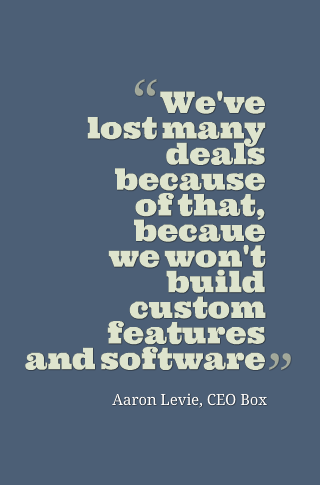 Or the best one is “We want to put a little interstitial that requires the user to type in which department they’re in, so there can be a chargeback.”
Or the best one is “We want to put a little interstitial that requires the user to type in which department they’re in, so there can be a chargeback.”
Jason: You’ve never done one of those deals.
Aaron: What’s that?
Jason: You’ve never done one of those deals where you build a little one off piece for the big customer? You’ve always been able to say no?
Aaron: Out of 44,000 customers, we may have done that half a dozen times. When we do that, we have this secret back end system that we can turn on and off things. A few people have that. We’ve won thousands of deals where the customer request didn’t match what we were building.
The way that we solved that problem was, and this is the customer partnership side, was can you get the customer to understand why the way that you’re building it might actually better solve their problem? When you hear about that esoteric security thing, can you get the customer to understand that it makes complete sense through the lens of their responsibility and what they’re trying to solve?
But, if you implemented it in the way that it’s being proposed, then users aren’t going to adopt the product and then they’re going to be less secure ultimately. If you can have that conversation in partnership with the customer, they tend to be fairly thoughtful. Because they ultimately want to solve their business problem.
We’ve lost many deals because of that. One of our biggest categories of why we lose deals is because there’s some weird feature that we are philosophically opposed to, because we think it’s going to hinder what the user is trying to accomplish or what the business is trying to accomplish. If we can’t get the customer to agree with that, then we may lose that deal.
The good news is, assuming you have venture capital and other customers, time’s likely on your side because if you’re right about that, that customer’s going to come back to you.
Jason: Yeah, with a long view.
Aaron: We see that all the time. We see a lot of customers that will implement some wonky thing that they thought was going to solve their business problem because it felt really great on paper. Actually, in practice, it doesn’t work.
Jason: They don’t need it. What about pulling forward from the roadmap? If a customer wants something that you’ve got scheduled for the second half of 2016 and it’s a $5 million check, that’s negotiable with the product team, isn’t it?
Aaron: That’s a different issue because that’s your own tradeoffs of do you want to increase your ability to work with larger customers on this one vector or do you want to support some other specific priority?
Jason: It’s a tough one, right?
Aaron: It’s a tough one, but it doesn’t have the same philosophical challenges because, in theory, at least in the way that I’m reading your question, you’re not doing that as a one off, you’re doing that to get to the next stage. We’ve done that many times.
We have, at many moments, built something that was necessary for one tier of customer that didn’t break our product for anybody, but maybe we had to prioritize getting to that next tier versus maybe the 95th percentile thing that we wanted to do on the tier below it. We’re making those tradeoffs all the time.
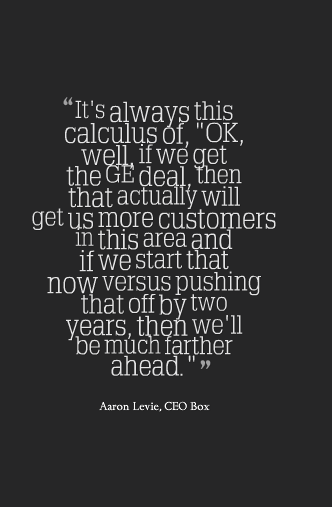 It’s always this calculus of, “OK, well, if we get the GE deal, then that actually will get us more customers in this area and if we start that now versus pushing that off by two years, then we’ll be much farther ahead.” That’s something that you just have to decide as an entrepreneur how do you want to prioritize those decisions.
It’s always this calculus of, “OK, well, if we get the GE deal, then that actually will get us more customers in this area and if we start that now versus pushing that off by two years, then we’ll be much farther ahead.” That’s something that you just have to decide as an entrepreneur how do you want to prioritize those decisions.
What we don’t do is build the thing that the customer wants that we think is going to break actually why they want to be in the first place.
That’s the really important decision making and discipline that you have to have in building these kind of products.
Jason: One last customer question, then I want to talk little bit about platforms because Box and platform is pretty interesting for entrepreneurs. Going back to spending more time with customers now, on the road, should have done more, ratio of prospects versus existing. There’s only so much time, right?
Aaron: Yeah. It’s interesting. The best advice I generally have is try and build a business model that once you sold to your customer, you can continue to grow with that customer. Either new capabilities, being able to sell more seeds. While it is absolutely true that in the SaaS model you want to spend a lot of time selling back to your customer because you want them to recur. That’s fundamental to the model.
It also helps if you can continue to increase their utilization and how they think of the product and the platform. Most of our customers go through an evolution. If you think about somebody at the scale of a GE or an Eli Lilly or Toyota, hundreds of thousands of employees in many cases, our first couple of years with them is largely secure file sharing and collaboration.
We’re not transforming every single way that they use their content. We have to go back in and say, “Hey, you haven’t been using us for this next generation workflow that we’ve been designing. Can we understand your business a bit more?” That dramatically benefits both of us because they get more value. We get a stickier customer in the process.
I spend a lot of time with existing customers. At the same time, we’re only in about half of the Fortune 500. We want to make sure that we’re in essentially all of the Fortune 500. We have to spend a lot of time with new customers as well. Any given city that I’ll go to, if we do one of these steak dinners, there’ll be 50 percent customers, 50 percent prospects and I’m trying to spend time with everybody.
Jason: Your gut is 50 / 50, something like that?
Aaron: I would have to…
Jason: The reason I ask is what most of us do, especially when we’re scaling fast, I believe we tend to spend as CEOs too much time with prospects, because that’s the hunt. We get that. We get that if we don’t go and fly to GE, this deal isn’t going to close. But that’s like 10 percent of the revenue that you’re ever going to get from GE.
My view is we all naturally, instinctively get the ratio wrong. The best way for Box to get from 250 to a billion is probably to go seed at GE and Toyota and Eli Lilly and make sure all those seeds deploy. Then, they’ll get you more customers and more case studies. Rather than getting pulled into Ford. Or maybe Ford’s a customer, but the next Toyota.
Aaron: Now, I’m going to say something that I don’t even know your thoughts on. Why don’t we talk about professional services for a second?
Jason: It’s a good topic.
Aaron: What’s your official take on it?
Jason: I think that personally I was an idiot not charging for professional services. It’s free money. Up to about 25 percent of your revenue, it still counts as recurring revenue. You have to do it anyway. The customers are happy to pay for it. I learned as a corporate vice president at Adobe, it’s already budgeted in procurement. You don’t even have to ask for it.
When the PO goes in, there’s a buffer for 15 to 20 percent for services. Then, there’s another buffer, and we’ll talk about platform, 15 to 20 percent for the other crap I have to buy to make that product actually work.. integration. I wanted easy to use product, but you’re an idiot to not take that 20 percent or whatever the number is. What is it for Box? I don’t remember it.
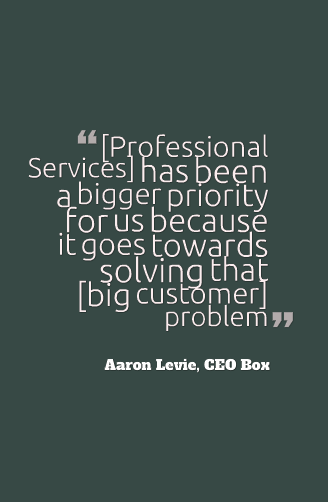 Aaron: Right now, it is far less than that, but it’s been a bigger priority for us because it goes towards solving that problem, which is, “OK, we’ve got this great customer. They are deploying the product, but why don’t we have an active conversation and strategic conversation with everyone of their IT architects at all times on how can they be using us more? How do we make that not be any kind of tradeoff decision for us?”
Aaron: Right now, it is far less than that, but it’s been a bigger priority for us because it goes towards solving that problem, which is, “OK, we’ve got this great customer. They are deploying the product, but why don’t we have an active conversation and strategic conversation with everyone of their IT architects at all times on how can they be using us more? How do we make that not be any kind of tradeoff decision for us?”
Normally, if they’re not paying for it, then you’re going to have to say, “Well, how do we balance all of these customer success managers’ time with all of these customers?” If we can have a partnership with GE, where they’re funding the ability to find all these new use cases, that’s actually a great partnership for both of us.
If you’re having to be responsible for that 250 to a billion, then you might want to also look at investing in some other areas. I still am pretty balanced with my time.
Jason: Box are interesting on platform level to me for a bunch of reasons. Let’s first go back in time, early days, Open Box. You invest in a platform because before Box is in any way big enough to be a platform. Maybe, challenge me on this. Give me your thoughts on two sides. How do you build the platform? How do your partners make money off it? How do attach rates work, scale?
I think Box tried to push the envelope of time and be a platform as early as you could be in the lifecycle of a company, right?
Aaron: What you’re referring to is now a retired brand that we called Open Box, which was 2008, I believe. That was our first way to take data from Box and open it and use it in applications such as EchoSign. Were you guys one of the launch partners of that?
Jason: One of the first ones, a long time ago. I didn’t even know what was going on, but “Sounds good, let’s do it!”
Aaron: We are old school. Funny enough, I think I received checks in the mail from you guys for a long time.
Jason: You did. I hand signed them.
Aaron: Indeed. [laughs]
Jason: Straight to you, yeah. [laughs]
Aaron: We were getting like $200 referral fees. Those were good days.
Jason: [laughs] That’s beer money.
[laughter]
Aaron: We had APIs in our first year, back in 2006. The original idea was, “Well, if you’re storing your data in Box, we’re only going to build one interface for you to access that information. There are potentially thousands of interfaces that you want to be able to pull up your data from.”
We built the APIs very early on and then the next step was, “OK, how do we actually encourage more utilization of that from customers.” We built Open Box, which opened up the platform a bit more for users. Then, we eventually, two or three years later, early 2010 timeframe, we said, “We need to expand this even further.”
Mobile was emerging, obviously, as a very hot topic. We said, “Well, one of the unique things about mobile is there’s not really a file system concept in the same way that there is in your desktop.” There needs to be a cloud file system. If you’re building an enterprise application, what’s going to happen is you’re going to be creating data and content that the enterprise is going to care a lot about.
If you have an app that has note taking or collaboration or a document workflow, the value proposition is somewhere in the IP and the user experience and the workflow. It’s not necessarily in the data storage. Maybe you would be storing that content in Amazon or something, but it’s clearly not the storage component.
We said, “Well, what if we could go into enterprise and say Box is the common layer where you manage your content, but it’s accessible and usable by any application that you give permission to.” We said, “If we could do that, then maybe we could actually, potentially, be a driver of revenue, driver of growth for the application ecosystem.”
I think we’re still early in all of the ways that needs to manifests throughout our business. We need our sales team to be better equipped to be pushing on the best in class applications. Our marketplace leaves some room for improvement. We have to improve that experience.
We’ve tested different economic models, different revenue sharing models in the app ecosystem, so we’re trying to…
Jason: It takes a while to figure that one out.
Aaron: …figure that. It really does. In general, what we do know for a fact is that we have a lot of customers that are standardizing on Box. We’re going to be the layer where they manage the security and control and then storage of the data. There’s an ecosystem of thousands of amazing applications that create content or can leverage the data already in Box.
We can, hopefully, accelerate the adoption of those applications if you can already pass the security tests, if you already have that assurance that your data is going to be in a platform that’s been vetted. The one thing that we all have to deal with because of the information economy and the data economy, data is becoming essentially the most important asset for enterprises. For GE that was probably a year of auditing and control testing and…
Jason: From signature, but before deployment or pre signing up a deal?
Aaron: Pre signature.
Jason: A year.
Aaron: We had to spend a year on working with the security team, the compliance team, the risk team. We did audits, testing…
Jason: All hoping to close the deal.
Aaron: Yes, exactly.
Jason: Even now. It spends a year for Box to get through that.
Aaron: See your financials. You spend a lot of money because not everybody buys this stuff on day one.
Jason: For sure.
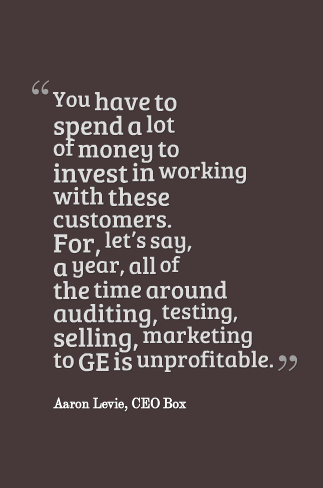 Aaron: You have to spend a lot of money to invest in working with these customers. For, let’s say, a year, all of the time around auditing, testing, selling, marketing to GE is unprofitable. We’re just praying every night that GE comes onboard and agrees with our strategy and then converts.
Aaron: You have to spend a lot of money to invest in working with these customers. For, let’s say, a year, all of the time around auditing, testing, selling, marketing to GE is unprofitable. We’re just praying every night that GE comes onboard and agrees with our strategy and then converts.
We’ve done a lot of that work for a large number of enterprises. If we can hopefully save people on that time and energy, and instead let you focus on building a world class mobile application or a world class workflow application, then hopefully we can drive way more innovation in the enterprise. That’s essentially our platform model and our API model right now.
Jason: Let me ask you a revenue question around that. There’s two reasons that as a vendor I might integrate with Box. One is because I need to or it makes my product better. It’s nothing to do with money. Mobile are in Box, there’s a lot of synergies here. The money is irrelevant.
Then, there’ll be folks where the attach rate’s important. I don’t know what their exact number is, 250 million, I’m using a round number. Can I get to $2.5 million off a Box as a lead source today?
Jason: …as a lead source. Because here’s the thing. I think you’re lucky to get a one percent attach rate if you’re lucky and you work incredibly hard. What percent of sales first customers does Box have after all these years? It’s not 10 percent. Maybe it is accidentally, but not through sales force as a lead source, for example.
The interesting question is; can people make millions of dollars off of Box now, as a lead source?
Aaron: This is a great question. What we realized was we had to begin to dimensionalize our customer base a little bit differently if we were going to go accomplish that. Let’s have a show of hands (looks to audience), who’s building an application that has an industry focus or industry orientation to it? OK. Who’s building something that is more function based, job function based? OK, interesting. Who’s everybody else?
[laughter]
Aaron: Products for a hundred percent of their custom base. Who is doing something that is universal every employee and the whole company could use it?
OK, cool. What we realized was depending on which category you’re in, there are different economic values that we could drive, right? If you’re building a deep industry workflow, you actually could make more money from that customer than we can.
If you’re building a job function app, then we have to find a way to get that job function app to the right part of our customer base. If you built a universal, then we have to figure out, how do we go to market together, across the entire customer base.
We built this thing called Box for industries, last year, which is we announced last year and we said, “Can we take some of the leading applications that are more industry focused?” This was just the first foray into being a lot more concert, having a much more concerted effort.
We said, “Could we take a bunch of solutions by industry?” If you go to a website and you go to the retail page or you go to the media and entertainment or the financial services page or whatever or the healthcare page, you’re going to see partners listed out. We basically want to continue to expand that.
If there’s a world class application that does something with medical information and can send medical information to our platform, we want to list that right in our whole healthcare solutions set.
And then really where the rubber meets the road is, because of our professional services, what we’re trying to build out is also industry orientation to professional services. If our PS team can actually say, “Here are the 5 or 10 best industry apps for this industry,” can we actually help you implement them to go solve additional problems that you’re going to be running into?
We’d like to have an end to end view of from the first time you touch our website to the first sales conversation to the proof of concept all the way to implementation. How do we actually take a platform and a partner point of view to that process? That’s what we’re working on.
Definitely email us if you haven’t, because this is what we’re building out right now.
Jason: One question I’m curious, because Box did a lot of things super early. What I’m wondering if you did later was true verticalization. You meet anybody that came out of SAP in the ’90s and the first thing they say when you meet them at a hundred million in revenue is “We’ve got to have Box for healthcare.” They tell you this is the roadmap, at like half a million in revenue. It seems to me maybe Box didn’t have true specialized teams and verticals until maybe you’re at a hundred million. I’m guessing. Maybe you had it early on, but I don’t think it was early.
Aaron: We didn’t. Really and I would say really until maybe a fraction of our sales force is verticalized in any way, even now.
Jason: Is that late? Obviously Box is doing great, but thinking about it in learnings is…
Aaron: It’s hard, because this is the age old segmentation challenge. Do you do territories, do you do size of company, do you do verticals? You’re always in the matrix of complexity. You have to be able to get enough value from your customers in any given territory to be able to even specialize on verticals within those territories.
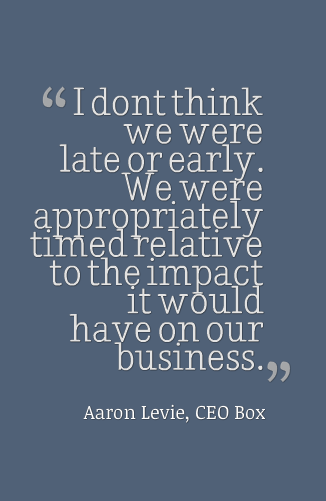 I don’t think we were late or early. We were appropriately timed relative to the impact it would have on our business. The key distinction is in “Crossing the Chasm,” hopefully everybody’s read this, this is the bible for building enterprise software. There’s a couple important updates that I think Jeff Moore would make and agree with, which is when you’re in the ’90s and you had this top down cellular software to get in in the first place, then you had to make some really, really key early tradeoffs.
I don’t think we were late or early. We were appropriately timed relative to the impact it would have on our business. The key distinction is in “Crossing the Chasm,” hopefully everybody’s read this, this is the bible for building enterprise software. There’s a couple important updates that I think Jeff Moore would make and agree with, which is when you’re in the ’90s and you had this top down cellular software to get in in the first place, then you had to make some really, really key early tradeoffs.
You had to actually decide, “Where am I going to get a flywheel effect going?” There’s no such thing as the Fortune 500. I can’t host an event for the Fortune 500. I can’t host an event for the Fortune 500.
You can get a flywheel, though, at a sublevel of that. I can get a flywheel going in life sciences. I can get a flywheel going in energy companies. In the ’90s you actually had to verticalize very early on, or you had to go after a very specific need, because it actually was the only way that you were going to be able to build the sales and marketing engine because it was going to be very people based and people have priorities and all of these challenges with humans.
In the Internet world and in inbound world, when we launched Box, and it was called box.net at first, when we launched box.net, within the first month, we had people in government. We had universities. We had energy. We had consumer packaged goods.
We didn’t actually have to make those kinds of decisions. Really until we started to begin to do the deeper, at least where we had the leading indicators that we could do more transformational kinds of customer projects, where we could actually reinvent how a hospital used all their medical documentation and medical images, we didn’t really actually have to verticalize. Now this is becoming a new layer to our business.
Jason: We’re just about out of time. Anything you want to hit that we didn’t hit?
Aaron: Any advice for me?
Jason: Any advice? That’s a good question I don’t know the answer to. I think my advice is actually, I was chatting with someone about this last night, is enjoy the second decade. You’re in the second decade. It’s a good time. It’s a good place to be. Getting through those first five years can be really hard, for everybody.
Aaron: Your advice is enjoy the second decade.
Jason: I think so. The world will not end. Box is going to be a success no matter what. Let’s enjoy the second decade. That’s my advice.
Aaron: That’s some knock on wood commentary. Are you going to launch something? What are you doing?
[laughter]
Aaron: Or are you just trying to make lots of money off all of us?
Jason: We’re making nothing. We’re hopefully to break even. I think our goal is just to help the next generation and distribute all the stuff we had to learn, these people don’t have to learn it. They can just figure out how to make a better product.
Aaron: Yeah, but then there’s going to be some other weird twist to the story.
Jason: There will be and then the next guy can do that one. That’s fine. That’s the natural evolution. All right, can you stay for a minute with Bob, if he’s here?
Aaron: Yes, absolutely, of course.
Jason: Thank you, Aaron, very much. Yeah.
Aaron: Yeah.
[applause] …

